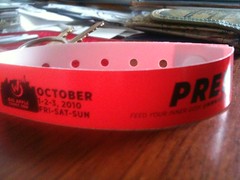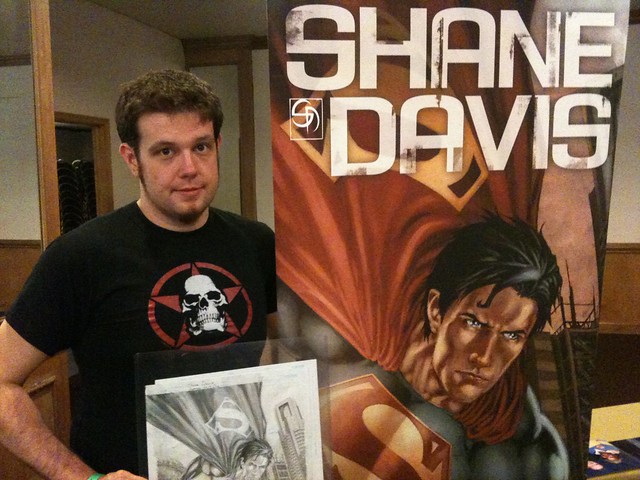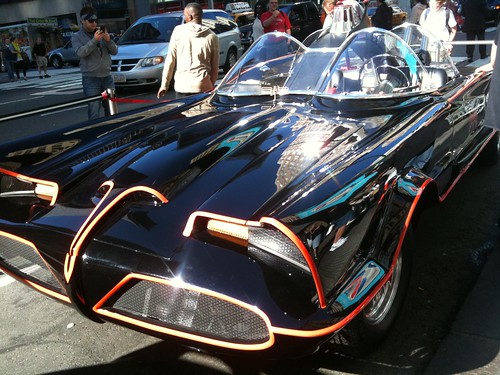That is the best way to convince people this stuff is worth their time. By showing them. But a random confluence of events has brought together some particular comics in my shoulder bag. These comics together represent many of the talking points I think might help people to recognize comics as the separate, viable, wonderful art medium it is. And as I walk the streets of New York City I thought I would share with you what they are and why I think they might work as somebody's 'first comic'.

Some of these I bought just recently, some of them were given to me as birthday presents, some of them I have because I'm reading them, some of them because I am or was reviewing them, or both the former and the latter:
"Electric Ant" #1
From Icon (an imprint of Marvel Comics), David Mack's and Pascal Alixe's adaptation of Phillip K. Dick's prose novel
Opening a comic such as this one can lead to thoughts like: Oh, a smart adaptation of a prose novel? It's really not a new edition is it? Comics isn't just illustrated prose. It's a different experience of the same story. Not a translation, an adaptation. Just the idea that a book can become a comic in the same way a book can become a film encourages one to think of it as smart mass media entertainment instead of junk. And it's by David Mack (@davidmackkabuki), of "Kabuki" fame. So you know it's good.
"Captain Swing and the Electrical Pirates of Cindery Island" #2
From Avatar Press, Warren Ellis' and Raulo Caceres' steampunk crazy time
Well... This one's crazy and perhaps not great for most new readers. Shocking an old lady with bloody violence and guns that shoot tiny light bulbs for bullets probably won't endear her to my beloved sequential art. But someone who digs steampunk, someone who likes things off the beaten path. Pirate ships flying on electric oars? They should see this stuff. The imagination owned by Warren Ellis (@warrenellis) has few equals in the field of comics. The evidence of vibrant imagination in the art-form is priceless to an argument that it should be appreciated. I bought issue #1 on a whim and I'm glad I did.
"Superman: Earth One"
DC's experimental graphic novel written by J. Michael Staczynski and drawn by recent L & S interviewee Shane Davis
This one has blown not only individual brains but the entire industry straight to the ground. A depiction of Superman as a 20-year-old young man with the problems of the average modern American 20-year-old: what the fuck do I do with my life? how the fuck do I do it? why am I doing it? To see a superhero character made so simply and easily relatable would no doubt be a major eye-opener to many who see superheroes (most particularly ones like Supes) as dumb jocks in a cape. No, the main genre found in the medium isn't only punching and explosions. My review of this just went up days ago.
"Captain America: Man Out of Time" #1
A new series from Mark Waid and Jorge Molina about one of Marvel's first superheroes
Speaking of recent comics re-telling a superhero's story from their own point of view, this is another great-looking work. Captain America is, in the perception of the mainstream, probably the only more prissy superhero than Superman. But, as usual, the mainstream is missing the new trees because it is expecting to see an old forest. I was sold on this issue the moment I saw the way Waid (@markwaid) brought Cap from World War II through his frozen state to the present in two successive splash pages. Someone who doesn't know what mainstream superhero comics are actually like will be amazed to see so 'goofy' a character as Captain America presented with such imagination and gravitas.
"Amazing Spider-Man" #648
With a three-year debacle behind him (mostly) Marvel's Spider-Man moves on to the "Big Time" with Dan Slott and Humberto Ramos
Well... I haven't read this yet. But it ISN'T "Brand New Day". So it might be more new reader-friendly than Spider-Man has been for a few months to a few years, depending on your point-of-view. Dan Slott (@danslott) has a great ability with humor. Anybody with a funny bone would probably enjoy Slott's writing and thus prove that the Joss Whedon style of dramedy can be found in comics, further proving that it's capable of anything.
"Falling for Lionheart"
A glorious mash-up of the two worlds of American comics by Ilias Kyriazis, released on the same day as "Superman: Earth One" from IDW
Not having actually read this, I can only comment on what it looks like. But it looks like one of the best graphic novels of the year and maybe the best 'first readers' graphic novel I have ever seen. It tells the story of Lionheart, a super-powered man on a state/corporate-approved team of superheroes. It is also the story of a man who feels that something about this life is hollow and chooses to make autobiographical mini-comics to express his ennui. None of that is new material (superheroes beholden to centers of authority, characters who make comics about their lives), except of course the brilliant twist that these men are one-and-the-same! Yes, "Falling for Lionheart" is about a superhero who is also an underground comicsmith. A tortured artist superhero love story. The two strongest arms of American comics re-introduced in one slim volume. I'm going to LOVE it. Look for a review soon.
I hope this silly list serves a few purposes for you, dear L&S readers:
1. I hope it has laid out just a little bit more of the incredible variety available in the medium of sequential art.
2. I hope you now know that you can ask me for reading material, if you ever see me on the street!
3. I hope you have some ideas about how to get that special STUBBORN someone in your life to give comics a chance. Lord knows there's plenty of them left out there...
~@JonGorga







 SD: Go work an Earth One project, you'll be alright.
SD: Go work an Earth One project, you'll be alright. This past weekend was the Big Apple ComicCon, a Wizard Magazine sponsored con, and I must tell you -looks left- -looks right- I didn't expect to have as much fun as I did!
This past weekend was the Big Apple ComicCon, a Wizard Magazine sponsored con, and I must tell you -looks left- -looks right- I didn't expect to have as much fun as I did! 



